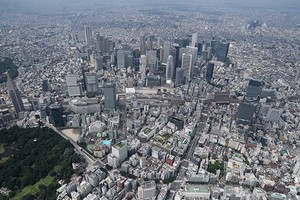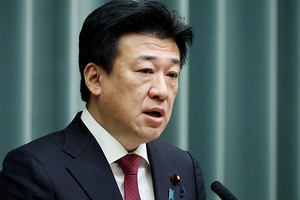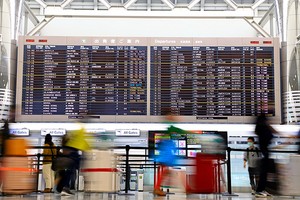THE ASAHI SHIMBUN
April 3, 2025 at 17:48 JST
 Passengers check the Tobu Tojo Line's train display at Ikebukuro Station in Tokyo’s Toshima Ward on Feb. 20. (Jin Hirakawa)
Passengers check the Tobu Tojo Line's train display at Ikebukuro Station in Tokyo’s Toshima Ward on Feb. 20. (Jin Hirakawa)
Signage for train destinations in multiple languages is becoming increasingly common on train station platforms, particularly as the numbers of foreign tourists hit record highs.
Even so, online criticism has appeared claiming the signs "are difficult for Japanese people to adapt to."
“It is annoying,” and, “Only Japanese and English are fine” are other online gripes concerning displays that cycle through languages including Chinese, English and Korean.
Asahi Shimbun reporters visited Tokyo's Ikebukuro Station in February to get a better scope of how some everyday commuters feel.
UNBURDENS STATION STAFF
“It doesn’t bother me. I can read English and Chinese characters,” a passenger in his 20s said when asked.
“Japan’s train operation systems are very complicated. So, I think the multilingual displays are good, because people from various countries can use it easily,” another passenger in her 50s said.
On the electric sign board at the ticket gates of the Tobu Tojo Line, the language with train destinations shifts every handful of seconds.
Japanese is shown for 10 seconds. Following this is English lasting eight, Chinese for four and Korean for four seconds. One cycle spans 26 seconds.
Tobu Railway Co. explains the addition is because there are also foreign riders. Regarding the criticism on social media, it will “consider it as a reference.”
A 23-year-old man who works for a railway company in the Tokyo metropolitan area said, “I understand people’s desire to gain information in a short time.” However, he also said that despite the inconvenience for Japanese passengers, multilingual displays are still necessary.
The concern is that if many international tourists who cannot read Japanese signs ask station staff for train information, employees may not be able to handle all the requests, especially with reduced numbers.
Daisuke Sawada, a researcher at the Foundation for Promoting Personal Mobility and Ecological Transportation, also believes that multilingual platform displays are useful for reducing the workloads of station staff.
This comes with a caveat.
“If it becomes difficult for Japanese people, the largest portion of passengers, to gain information, it would be putting the cart before the horse,” Sawada pointed out.
LURKING ANXIETIES
Many railway companies are making efforts to improve their displays, taking into account guidelines issued by the transport ministry on how to provide information to foreign tourists.
The number of languages shown also varies by entity.
Under the Transportation Bureau of the Tokyo metropolitan government, signs at stations and on trains are essentially shared in four languages: Japanese, English, Chinese and Korean.
However, Japanese is always displayed on station bulletin boards and other places.
Keikyu Corp. alternates between four (Japanese, English, Chinese and Korean) and two (Japanese and English) languages; it also has a system where destinations displayed at stations are always in Japanese.
Tokyo Metro Co. alternates showing train information in Japanese and other languages. Hiragana readings above foreign text is also included, in principle.
Keio Corp. displays train information in four languages, considering the need to disseminate information in the event of a disaster.
East Japan Railway Co. (JR East) and Seibu Railway Co. typically display station and onboard signs in Japanese and English. Seibu Railway incorporates four languages on the signs aboard some of its limited express trains.
Despite the variety and only seconds of waiting before Japanese text rolls back around, criticism of the systems remain.
Takahiro Akedo, associate professor of sociology at Osaka Metropolitan University, said the issue of improving convenience, such as making station boards easier to read, needs to be separated from xenophobic claims.
Akedo believes that the larger context for the pushback against multilingual signage is “anxiety about the future,” and added, “Amid growing anxiety about the future of Japan and the world, it is easy for socially vulnerable minorities to become a target.”
Japan will continue to accept people from overseas, whether as visitors or residents, because the country is suffering a labor shortage.
“We will need to overcome language and cultural differences between Japanese and foreigners. We can’t coexist with them by just excluding those that infringe on our convenience,” Akedo said.
(This article was written by Jin Hirakawa and Hiroshi Nakano.)
***Examples of destination signs from major railway companies based on responses obtained from each company**
JR East: Japanese and English are displayed at stations.
Keio: Station signs and guides on trains are displayed in four languages: Japanese, English, Chinese and Korean. Japanese is displayed preferentially on trains.
Keikyu: Four languages and two languages of Japanese and English are displayed on electronic boards in station concourses and platforms.
Tobu Railway: Guides in stations and on trains are displayed in four languages.
Transportation Bureau of Tokyo metropolitan government: Basically information is displayed in four languages. Japanese kanji characters are always displayed on station boards and other information boards.
Tokyo Metro: Four languages are displayed at stations. In principle, Japanese and foreign languages are displayed alternately, with hiragana readings also provided to foreign language texts.
Osaka Metro Co.: Information boards installed at stations and on trains are in up to four languages.
Nagoya Railroad Co.: Up to four languages are available on some trains and at major stations related to access to Chubu Airport.
Nishi-Nippon Railroad Co.: Electronic boards at stations and platforms are displayed in four languages. In-train announcements are in four languages on sightseeing trains. Japanese only elsewhere.




















A peek through the music industry’s curtain at the producers who harnessed social media to help their idols go global.
A series based on diplomatic documents declassified by Japan’s Foreign Ministry
Here is a collection of first-hand accounts by “hibakusha” atomic bomb survivors.
Cooking experts, chefs and others involved in the field of food introduce their special recipes intertwined with their paths in life.
A series about Japanese-Americans and their memories of World War II